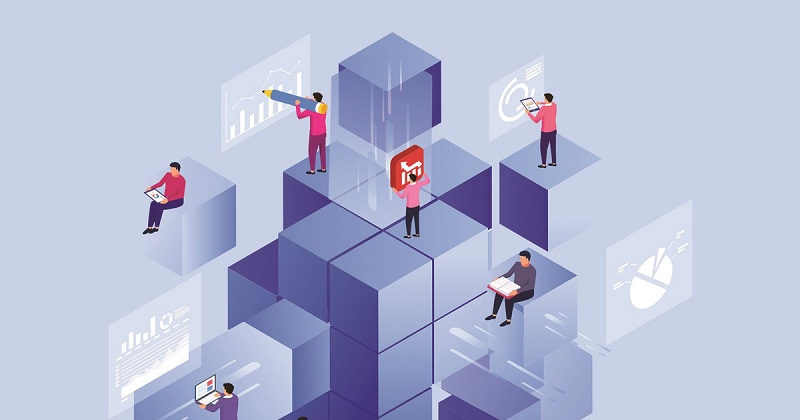Unlocking the Potential of Blockchain: Cutting Educational Costs Dramatically
Hey there! Imagine slicing your education bills in half or more. That’s the potential of blockchain for reducing educational costs, and it’s no pipe dream. With blockchain, we’re paving the way to cost-saving education that doesn’t skimp on quality. Think cheaper tuition, less spending on managing student records, and an overhaul of learning platforms that puts money back in your pocket. It’s time to deep dive into how this tech can change the game for learners and institutions alike. Get ready to explore a world where education doesn’t mean a mountain of debt. Let’s jump right in and unlock these benefits together!
Exploring the Cost-saving Landscape of Blockchain in Education
Implementing Blockchain to Slash Tuition Fees
Have you ever thought, “Why is college so expensive?” It’s not just you. Many folks feel that way. Good news—blockchain could make college cheaper. How? By cutting what schools spend on tasks like keeping records safe.
Can blockchain lower tuition fees? Yes, it can. When schools use blockchain, they spend less on keeping student records. This means they can charge less for classes. So you get to keep more of your money.
Using blockchain, schools can store info safely and share it fast. No paper needed. No losing your record. And no long waits! You get your info like grades and degrees faster and cheaper. Isn’t that cool?
Picture this: a world where every student’s info is just a click away. Safe, quick, and cheap. Blockchain makes this real. Saving records this way means schools can save loads of money. And they can pass on those savings to you.
Reducing Administrative Overheads with Decentralized Solutions
Schools have many admins to do things like enrolling and grading. This is pricey. Can blockchain tech help here too? You bet!
With blockchain, schools can use smart contracts. These are like self-run deals that handle stuff without many people. They can do jobs like sign you up for classes or let you know if you pass an exam.
Smart contracts work non-stop and don’t mess up. So, schools need fewer people to do these jobs. That means they can save on worker costs big time. This helps make class fees lower for students.
Decentralized systems in education can also help save money. Instead of one big computer that does everything, many shared computers work together. This can be cheaper to run and can keep things going smoothly. Even when one computer has an “oops” moment. Lower costs here can mean lower costs for you to learn.
By making these changes, schools can save stacks of cash. And the best part? They can help make learning less pricey for every student. This way, the chance to learn and grow is open to more people.
That’s what blockchain offers. A smart way for schools to save time, energy, and money. And a chance for you to get the learning you dream of at a better price. Now, that’s a win-win if I ever saw one!
Secure and Streamlined Student Records with Blockchain
Blockchain Student Records Management
Every student has a pile of records: grades, diplomas, and course lists. What if they could snap their fingers and have all their info safe and easy to share? That’s what blockchain can do for student records. It locks up data like a treasure chest. Schools can use blockchain to keep records that never get lost or torn. No one can change them, not even by mistake. This means less worry about losing your important school papers.
Blockchain in schools saves time and money. How? Think about all the staff schools need to handle files. With blockchain, we cut down on that. Fewer people are needed to find and share records. So, schools spend less money on these tasks. With this tech, schools can share your records quickly when you need them. Say goodbye to waiting weeks for your transcript!
Credential Verification and the Role of Decentralized Ledgers
Ever show your diploma and wonder if they trust it’s real? Well, blockchain fixes that. Schools use blockchain to prove your hard work is valid. They keep a list of all diplomas that can’t be messed with. This list is called a decentralized ledger. When you apply for a job or more school, they can check this list. They see right away that you earned your stripes.
Why is this so great? Because it takes away the long checks that cost you time and money. Employers and schools can check your credentials fast, with no doubts. It’s a quick peek, and they know you’re the real deal. It’s also cheaper for schools. They don’t have to have people sitting around, sending out papers. They just let the blockchain ledger do the talking.
Both these ways show how blockchain is more than just tech talk. It’s a real tool that makes school life cheaper and smoother. It’s like having a personal librarian who guards and shares your book of life. Thanks to blockchain, your achievements are always ready to shine without the extra cost and hassle.
Blockchain-Enabled Learning Platforms: A New Era for Affordability
Peer-to-peer Learning and Scholarship Ecosystems on the Blockchain
Blockchain isn’t just for tech pros. It’s for our schools too. It lets us connect with others to learn and share knowledge without a big price tag. Just think of it like a digital school yard where every student meets to swap notes and ideas, without needing lots of money.
Imagine a platform where learners teach learners. That’s peer-to-peer learning in action. It’s like helping a friend solve a hard puzzle. On the blockchain, smart tech makes sure everyone gets fair help. This cuts costs big time. No need for costly books and classes when you can learn right from your pals!
How about getting money for school that’s clear and fair? With blockchain, we can see where every penny goes. Scholarships on blockchain let students get needed funds without the worry. It takes away the middleman, saving time and money.
Smart Contracts for Transparent and Efficient Educational Services
Now, let’s paint a picture of a smart contract. Think of it as a deal that makes itself happen. When you do your part, like finishing a course, it gives you a digital high-five. And maybe even some cash-back! That’s how smart contracts support education. They lower costs by making sure every deal is clear and keeps its word.
These contracts can handle payments for classes, books, and more. Everything’s listed clear as day. No more lost papers or mix-ups in payment.
And guess what? Blockchain can also keep track of grades and achievements. Safe and sound on the ledger, no one can change them. It’s all about making school smoother and cheaper.
Schools can save big by using blockchain from kindergarten to college. No more heavy filing cabinets or lost records. All the big school tasks, handled fast and without fuss.
We’ve talked about cutting costs by letting students teach one another. Also, about using tech to manage funds and keep promises. This all adds up to making school better for everyone. And the best part? It doesn’t cost much.
To sum it up, using blockchain smartly in schools means big savings. It makes learning easy to get to, fair, and open for all. It’s about giving every student a chance, without the wallet worry. It’s time to embrace this wave of change – making education better, one block at a time.
The Future of Academia: Blockchain’s Role in Curriculum and Policy
Integrating Blockchain into Educational Curriculum Development
Schools are starting to teach kids about blockchain. This tech is not just for computer pros. It’s for everyone! With blockchain, we keep info safe and sound. It is like a block tower. Each new block keeps the others in place.
By teaching blockchain in schools, we help students learn about the future. It’s smart, too – this way, schools show they are up-to-date. Kids can learn to build apps, protect data, and more. They can even learn to make their own digital money!
We don’t just talk big; we act. In my work, I help schools use blockchain. We look at what jobs need these skills. We build classes that give those skills. This means when kids grow up, they can get good jobs. Everyone should get this chance, right? We think so.
Crafting Cost-effective Education Policies with Blockchain Technology
Money talks, and in education, it speaks volumes. Schools need money to run. Yet, it costs a lot! Books, classes, and more pile up. Here’s where blockchain helps. It helps schools use money better and cuts costs. How? Let me tell you.
Blockchain makes it easy to see where money goes. Every penny gets tracked. So, we know if someone’s not playing fair. We also cut out the middle man. Money goes straight where it’s needed, like helping kids learn.
Scholarships? Yes, blockchain helps here too. It can make sure the right kids get help. It’s fair, quick, and no cheating.
And the best part? We can prove it works. Schools I work with save money. They smile more, worry less. Teachers focus on teaching. Kids can afford to learn. That’s the goal, and blockchain is helping us get there.
With blockchain, education can change. It’s not just talk. It’s real change, for the better. We want kids to succeed. Blockchain hands us the right tools. Let’s build a smarter, fairer future for education. Let’s do it with blockchain.
In this post, we explored how blockchain cuts costs in education. We learned how it can lower tuition fees by changing how schools handle money. It also reduces admin costs by using smart, decentralized systems.
We saw how blockchain makes student records safe and easy to manage. It also simplifies how we check credentials. This means less hassle and less fraud.
We talked about blockchain platforms that support peer-to-peer learning and scholarships. This could make learning cheaper for everyone. Also, smart contracts make paying for school services clear and fair.
Finally, we looked at blockchain’s future role in shaping what we learn and how we make education policies. It’s all about making smart choices to save money.
Thinking about all this, it’s clear that blockchain is not just a tech trend. It’s a strong tool that can reshape education for the better. It’s a way to make school fair, affordable, and efficient for us all. Let’s embrace this change and keep pushing for smart solutions in our classrooms.
Q&A :
How can blockchain technology lead to cost reduction in education?
Blockchain technology holds the promise to streamline numerous administrative procedures in educational institutions. By using this technology, schools and universities can automate processes such as record-keeping and transcript evaluations, potentially reducing the need for costly intermediary services and administrative personnel. Moreover, blockchain could provide cost-effective ways of credential verification, saving both time and resources for students and academic organizations.
What are the potential savings for students through blockchain in education?
Students stand to benefit significantly from blockchain’s integration into the education sector. This technology has the potential to reduce costs associated with purchasing textbooks and other learning materials by facilitating the sharing of digital resources. Furthermore, blockchain-based systems could lower transaction fees for tuition payments, especially for international students, by eliminating the need for third-party payment processors.
How does blockchain improve access to education?
Blockchain could democratize access to education by providing a platform for secure, affordable, and verifiable educational records and credentials. With a decentralized approach, blockchain can facilitate scholarship distributions directly to eligible students and enable people, irrespective of their location, to access online courses and certifications. This accessibility can reduce both direct and indirect educational expenses for learners worldwide.
Can blockchain reduce the cost of educational administration?
Yes, blockchain technology can significantly reduce administrative costs in educational institutions. It offers a secure and efficient way to manage records and transactions without the need for intermediaries. For example, verifying student credentials could be made faster and cheaper, as blockchain creates an immutable ledger that simplifies the validation process, thereby reducing administrative burdens and associated costs.
Is there a real-world example of blockchain reducing educational costs?
Indeed, there are emerging cases where blockchain technology is being implemented to reduce costs in education. For instance, the University of Nicosia in Cyprus uses blockchain to issue digital diplomas, cutting down the costs and time associated with the traditional diploma issuance process. Similarly, platforms like Sony Global Education are utilizing blockchain to provide a global database for sharing educational data, potentially reducing the cost of educational content distribution and verification.


